Khilafat
Introduction
A Khalifa literally means a ‘successor’. Khalīfah is an Arabic word used in the Qur’an to denote a person who succeeds or represents a forebear. The institution as a whole is called Khilāfah, which is referred to on the Indian Sub-continent as Khilafat. The Holy Qur’an specifically promises the Muslim Community that ‘Khilafat’, or ‘successorship’ will remain among them after the demise of the Prophet Muhammadsa,
Allah has promised to those among you who believe and act righteously, that He will surely make them Successors (Khulafā) in the earth, as He made Successors from among those who were before them; and that He will surely establish for them their religion, which He has chosen for them; and that He will surely grant them security and peace in place of their fear.
(Holy Qur’an, 24:56)
This verse clearly and explicitly foretells the appearance of Khulafā, (the Arabic plural of ‘Khalifa’), among the Muslims as there were among previous peoples. These Khulafā will come to establish the faith, and to give people ease and security at a time of fear. The Promised Messiah, Hazrat Mirza Ghulam Ahmadas explained the need for Khulafa as follows:
‘A successor is called a Khalifah. The successor of a prophet in the real sense can only be the one who has the excellences of a prophet on a shadowlike basis…in fact a Khalifah is the shadow of a prophet. As no person can live forever, therefore Allah the Exalted willed to establish the beings of prophets, who are the most eminent and the best among all the beings of the world, on a shadow-like basis till the Day of Judgement. It is with this objective that Allah the Exalted chose Khilafat so that the world may never and at no time be deprived of the blessings of prophethood.’
(Shahadat-ul-Qur’an p.57 Ruhani Khaza’in vol. 6, p.353)
The Prophet Muhammadsa elaborated on the future appearance of Khilafat among his followers in a well-known narration:
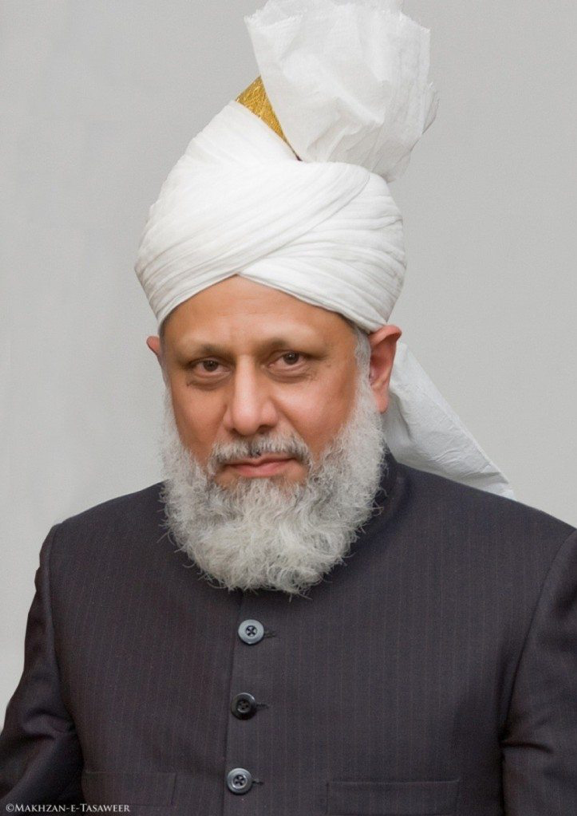
KHALIFA OF THE AHMADIYYA MUSLIM COMMUNITY.
“Prophethood shall remain among you
(Masnad-¬Ahmad, Mishkat, Chapter Al-Anzar Wal Tahzir).
as long as God wills. Then Khilafat on
the pattern of prophethood will commence and remain as long as
He wills. A corrupt monarchy shall then follow and it shall remain as long as God wills. There shall then be a tyrannical despotism which shall remain as long as God wills. Then
once again Khilafat will emerge on the
precept of prophethood.”
Thus the Prophet Muhammadsa foretold that after his demise, true spiritual Khilafat will emerge. Then would follow various phases of Islamic rule, each worse than the last, before ‘Khilafat on the precepts of Prophethood’ would reappear once more.
History has borne witness that every word of the Holy Prophetsa has been fulfilled. After his own passing, there emerged spiritual leadership in the form of the four Rightly-Guided Khulafa. Then there followed age after age of successive Muslim leadership, the integrity of which dissipated every century. Then, in the 19th Century, came the advent of the Promised Messiahas, a follower-prophet after the Prophet Muhammadsa. After Hazrat Mirza Ghulam Ahmad’s demise, there once again appeared Khilafat ‘on the precept of Prophethood,’ providing spiritual guidance in an age of worldly decadence.
The current Khalifa of the Ahmadiyya Muslim Community is Hazrat Mirza Masroor Ahmadatba, a spiritual light in this age of darkness, renowned throughout the world as a tireless campaigner for international peace and justice.
If you want to learn more about Khilafat after reading through these pages, you can discover more articles, books, and multimedia on the http://www.alislam.org website.
Types of Khilafat
The 2nd Khalifa of the Ahmadiyya Muslim Community, Hazrat Mirza Bashirrudin Mahmud Ahmadra delineated the different kinds of Khilafat in his erudite commentary on the following verse:
Allah had promised to those among you who believe and do good works that He will surely make them Successors in the earth, as He made Successors from among those who were before them; and that He will surely establish for them their religion which He has chosen for them; and that He will surely give them in exchange security and peace after their fear: They will worship Me, and they will not associate anything with Me. Then who so is ungrateful after that, they will be the rebellious.
(Holy Qur’an, 24:56)
He explained:
‘The present verse embodies a promise that Muslims will be vouchsafed both spiritual and temporal leadership. The promise is made to the whole Muslim nation but the institution of Khilafat will take a palpable form in the person of certain individuals who will be the Prophet’s Successors and the representatives of the whole nation. They will be, as it were, Khilafat personified. The verse further says that the fulfilment of this promise will depend on the Muslims’ observing the Prayer and giving the Zakat and on their obeying the Messenger of God in all religious and temporal matters concerning the nation. When they will have fulfilled these conditions, the boon of Khilafat will be bestowed upon them and they will be made the leaders of nations; their state of fear will give place to a condition of safety and security, Islam will reign supreme in the world, and above all the Oneness and Unity of God – the real purpose and object of Islam – will become firmly established.
The promise of the establishment of Khilafat is clear and unmistakable. As the Holy Prophet is now humanity’s sole guide for all time, his Khilafat must continue to exist in one form or another in the world till the end of time, all other Khilafahs having ceased to exist. This is among many others the Holy Prophet’s distinct superiority over all other Prophets and Messengers of God. Our age has witnessed his greatest spiritual Khalifa in the person of Ahmad, the Promised Messiah.
The Qur’an has mentioned three kinds of Khulafa.
- Khulafa, who are Prophets such as Adam and David. About Adam, God says in the Qur’an: “I am about to place a vicegerent in the earth” (2:31); and about David He says: “O David, We have made thee a vicegerent in the earth” (38:27).
- Prophets who are the Khulafa of another and a greater Prophet such as the Isrealite Prophets who all were the Khulafa of Moses. About them the Qur’an says: “We have sent down the Torah wherein was guidance and light. By it did the Prophets who were obedient to Us judge for the Jews:” (5:45).
- Non-Prophet Khulafa of a Prophet, with or without temporal powers, such as godly people learned in the Law. Their mission is to protect and preserve the law from being tampered with (5:45).
Briefly, the verse under comment covers all these categories of Khulafa, viz., the Holy Prophet’s rightly-guided Khulafa, the Promised Messiah, his Successors and the spiritual Reformers or Mujaddids. Their mission, as the above verse says, is to protect the Law and to bring back “the erring flock into the Master’s fold.”
The special marks and characteristics of these Khulafa are:
- They are appointed Khulafa through God’s own decree in the sense that the hearts of believers become inclined towards them and they voluntarily accept them as their Khulafa;
- The religion which their mission is to serve becomes firmly established through their prayers and missionary efforts;
- They enjoy equanimity and peace of mind amidst hardships, privations or persecution which nothing can disturb; and
- They worship God alone, i.e. in the discharge of their great responsibilities they fear no one and they carry on their duties undaunted and without being discouraged or dismayed by the difficulties that stand in their way.
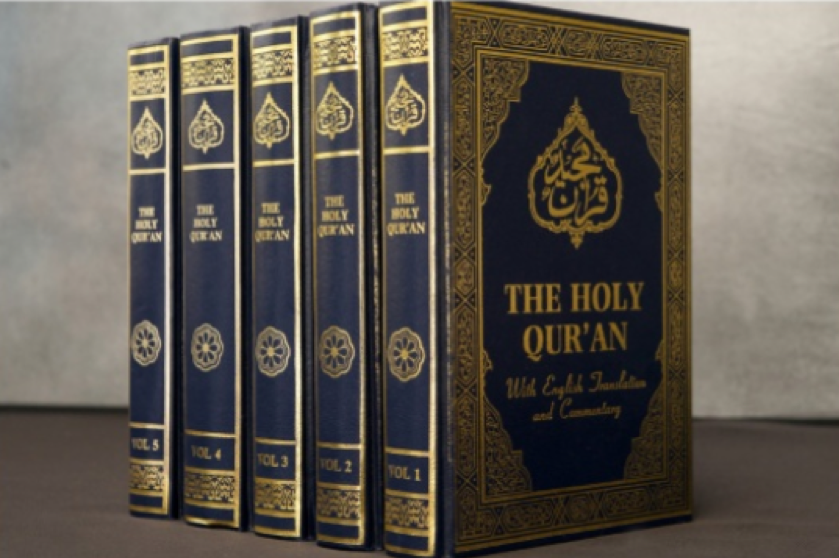
The verse may also be regarded as embodying a prophecy which was made at a time when Islam was very weak and idols were being worshipped throughout Arabia and the Muslims being small in number feared for their very lives, and yet in the course of only a generation the prophecy was literally fulfilled.
Idolatry disappeared from Arabia and Islam became firmly established not only in Arabia but also reigned supreme in the whole world and the followers of the Holy Prophet, erstwhile regarded as the dregs and scum of humanity, became the leaders and teachers of nations.
The words, “Whosoever is ungrateful after that, they will be the rebellious,” signify that Khilafat is a great Divine blessing. Without it there can be no solidarity, cohesion and unity among Muslims and therefore they can make no real progress without it. If Muslims do not show proper appreciation of Khilafat by giving unstinted support and obedience to their Khulafa they will forfeit this great Divine boon and in addition will draw the displeasure of God upon themselves.’
Rashidun Khilafat
Introduction
Khilafat-e-Rashida, or the Rashidun Khilafat, is a term signifying the ‘rightly-guided’ leadership of the Muslims after the sad demise of the Prophet Muhmmadsa in 632 C.E.. Thereafter followed 29 years which most Muslims, including Ahmadi Muslims, take as being a Golden Period in the history of Islam. In this era the four rightly-guided Khulafa maintained strength and unity among the Muslims while facing dire threats from within and without their spiritual kingdom. These Khulafa have become paragons of virtue and courage in the eyes of historians, and their achievements are still celebrated by Muslims and non-Muslims the world over.
Scholar Fareed Ahmad writes in his learned exposition of Khilafat:
“The golden thread that ran through the Khulafa-e-Rashideen and bound them together was their unstinting loyalty to Islam, their nobility of character and adherence to the teachings and practices of Muhammadsa. They also did not let anything detract them from defending the honour of the office of khilafat and some made the ultimate sacrifice in its defence. This loyalty enabled them to make great progress but they also faced great difficulties. Yet, despite this, they remained true to their faith and never let personal ambition encroach upon their holy mission. Indeed the Khilafat Rashida had no desire to lead but as they had been bestowed this position by God they led with sincerity of heart knowing that they were accountable to Him for their tenure in office.”
(Review of Religions, Oct. 2007)
Lieutenant-General Sir John Glubb wrote in The Empire of the Arabs, pg. 26:
‘Both Abu Bakr and ‘Umar had been close intimates of the Prophet and were utterly dedicated to the service of Islam. Like the Apostle himself, they were indifferent to money and continued when they had attained power to live simple peasant lives. Clad in patched garments made of coarse woollen material, they were not above milking their own goats as they had always done.’
Edward Gibbon wrote in The History of the Decline and fall of the Roman Empire, p.869:
‘An historian who balances the four caliphs with a hand unshaken by superstition will calmly pronounce that their manners were alike pure and exemplary; that their zeal was fervent, and probably sincere; and that, in the midst of the riches and power, their lives were devoted to the practice of moral and religious duties.’
The names of the four Khulafa were:
- Hazrat Abu Bakr Siddiquera
- Hazrat Umar Farooqra
- Hazrat Uthman Ghanira
- Hazrat Ali Ibn Abi Talibra
N.B.: Most Muslims will add an Arabic honorific, signified by (ra), after the names of the companions of the Prophet Muhammadsa. This honorific means ‘May Allah be pleased with them.’ In the Indian sub-continent, the title Hadhrat/Hazrat is also applied before their names, indicating ‘His Holiness.’
We will now provide brief overviews of their lives and achievements, extracted and edited from the book ‘Basics of Religious Education’ by Sheikh Abdul Hadi.
Abu Bakr
Period of the First Khilafat: 632 C.E – 634 C.E.
Early Life
The personal name of Hazrat Abu Bakrra was Abdullah, but in respect of his fatherhood he was known as Abu Bakr. His father was known as Abu Qahaafah and his mother as Ummul Khair Salma. His lineage can be traced back to the Holy Prophetsa in the sixth generation before him.
He was born in 572 C.E. in Mecca and was raised there. When he came of age, he became a cloth merchant. He was the closest friend of the Holy Prophetsa. He was the first man to confirm the truth of the claim of the Holy Prophet, and thus he earned the title Siddeeq. Throughout his life, he was fully devoted to the service of Islam.
Hazrat Abu Bakrra was the closest companion of the Holy Prophetsa and always remained by his side whether it was peace or war. The Holy Prophetsa sought his wise counsel in almost every matter where advice was needed. He was in the company of the Holy Prophetsa during his migratory journey (Hijrah) from Mecca to Medina. He was the only companion of the Holy Prophetsa in the Cave of Thaur, where they both took refuge during this journey.
Hazrat Abu Bakrra was a highly dedicated companion of the Holy Prophetsa and gave his daughter, Aishara, in marriage to him. He would always strive to surpass others in financial sacrifices. Once, for the Battle of Mautaa, the Holy Prophetsa was in urgent need of finance. Hazrat Umar presented half of all his belongings, while Hazrat Abu Bakrra brought all that he had in his house, to the Holy Prophetsa.
The Holy Prophetsa always held him in high esteem. Following the Hajjatul Widaa` (the Last Pilgrimage), when the Holy Prophetsa fell seriously ill, he instructed Hazrat Abu Bakrra to lead the daily prayers.
Internal Disorders
Firstly, there were a number of tribes who renounced Islam, simply because their tribal chiefs had political motives and therefore they did not want to remain loyal to the successor of the Holy Prophetsa. Hazrat Abu Bakrra sent troops and suppressed their politically motivated rebellion.
Secondly, many people refused to pay Zakat, which was essential for fulfilling the needs of the Islamic state and care for the poor. Hazrat Abu Bakra vowed to collect Zakat from everyone and took all the necessary measures to achieve this goal.
Thirdly, a number of treacherous persons started planning rebellion against the Islamic state. Hazrat Abu Bakrra was prompt to fight back these rebels so as not to allow discord threaten the peace of the nation.
“God has appointed me as Khalifa among you in order that I may create brotherly unity among you and establish the faith.”
—Hazrat Abu Bakrra
Preservation of the Holy Qur’an
Although, the writing and arrangement of the Holy Qur’an was done under the supervision of the Holy Prophetsa himself, yet it was written on various pieces of skin, leaves and slates. Hazrat Abu Bakrra collected all these pieces of writings in one place, and reorganized the Huffaaz (i.e. those who committed it to memory in a systematic way) for the preservation of the Qur’an.
His Demise
Hazrat Abu Bakrra passed away on August 23, 634 C.E., after fifteen days of illness. His period of Khilafat was a little over two years. During his Khilafat, Hazrat Abu Bakrra successfully established the integrity of the Islamic state against all internal disorders and external enemies. Also, he was able to unite the Muslims under the system of Khilafat.
This page is an excerpt from the book ‘Basics of Religious Education’ by Sheikh Abdul Hadi, with very minor amendments.
Umar Ibn Al-Khattab
Period of the Second Khilafat: 632 C.E – 634 C.E.
Early Life
His personal name was Umar, Farooq was his title, and Ibn-Khattaab was his family name. He was born in 581 A.D. in Mecca, and belonged to a noble family of the Quraish. He was a renowned businessman and used to lead trade delegations to Syria and Iraq. When the Holy Prophetsa announced his claim to prophethood, Hazrat Umar Farooqra became a fierce opponent of Islam. So much so, that one day he took up a sword and left his house with the intention to kill the Holy Prophetsa. On his way, someone told him to first deal with his own sister and brother in-law who had accepted Islam. He went straight to them and when he knocked at their door, he could hear the Holy Qur’an being recited inside the house. He became furious and started beating his brother-in-law, and wounded his sister who tried to protect her husband. His wounded sister said in a resolute voice, “Umar! You may beat us as much as you like, but we are not going to change our faith.” This made him calm down, and he asked them to recite a portion of the Holy Qur’an for him. He was so moved by the Qur’anic verses that his eyes filled with tears. He went straight to the Holy Prophetsa and accepted Islam at his hand. As he was a strong, fearless and influential man of Mecca, he proved to be a source of strength for the Muslims. This miraculous change in Hazrat Umar was in fact the result of the Holy Prophet’s prayers for him. Hazrat Umar devoted his wealth and dedicated his life for the cause of Islam. He was an intelligent and God-fearing person. He participated in almost all the battles along with the Holy Prophetsa, who used to consult him in many important matters.
His Khilafat
Hazrat Umar bin Khattaab was the second successor of the Holy Prophetsa. During the ten years of his Khilafat, the Islamic state expanded and progressed extensively. Peace and prosperity prevailed everywhere in the state. A brief account of his Khilafat is given as follows.
Conquest of Neighbouring Empires

During the period of his Khilafat, the Muslims had to fight a number of battles against Iran, Iraq, Syria and Egypt. As a result of this, vast areas of these countries came under the Muslim rule. When the city of Jerusalem was conquered by the Muslims in 17 Hijrah, Hazrat Umarra himself visited the city on the request of the Romans, and signed a treaty between the Muslims and the people of Jerusalem.
Administration of the Islamic State
Apart from the conquest of vast areas, Hazrat Umarra paid full attention to the welfare of his people. He was able to establish a splendid system of administration for the Islamic state and his Khilafat marked a golden period in the history of Islam. Some of his main achievements in this field are:
1. Establishment of Majlis Shoora, a Consultative Body of Advisors to the Khalifa.
2. Division of the whole Islamic state into provinces to facilitate administration.
3. Establishment of a finance department, and building of schools and mosques in
different parts of the state.
4. Introduction of the Islamic Calendar of Hijrah.
‘Anyone who needs monetary help, should come to me, as God has made me the Treasurer and Disburser.’
—Hazrat Umarra
His Character
Hazrat Umarra was a pious, kind and far-sighted man. He possessed the fine qualities of bravery, honesty and simplicity. He was so anxious about the welfare of his people that he used to go around in disguise, in the city of Medina at night, to see for himself if anyone was in need of help. Once, during his patrol at night, he observed a woman cooking something in a pot while her children were crying around her. He found out from the woman that her children were hungry for two days and the pot was put on fire just to console them. Hazrat Umarra immediately went to the treasury, and himself brought all the necessary food items to the woman. On his way, one of his servants wanted to carry the load but he stopped him by saying:
“On the Day of Judgement you will not carry my load.”
His Demise
In the year 644 C.E., Hazrat Umarra was stabbed by a Persian slave, while offering prayer in the mosque. This proved fatal and he passed away at the age of sixty-three. He was a truly great Khalifa whose period of Khilafat was undoubtedly a golden period in the history of Islam.
This page is an excerpt from the book
‘Basics of Religious Education’ by Sheikh Abdul Hadi, with very minor amendments.
Uthman Ghani
Period of the Third Khilafat: 644 C.E – 656 C.E.
Early Life
Hazrat Uthman Ghanira was elected the third Khalifa by the council appointed by Hazrat Umarra just before his death. He belonged to the well known family Banu Umayya of the Quraish. His lineage can be traced back to the Holy Prophetsa in the fifth generation before him. He was a famous and wealthy trader. His generosity for the poor was so well known that he earned the title Ghani (generous). Hazrat Uthmanra embraced Islam due to the preaching of his close friend, Hazrat Abu Bakrra. He was the fourth person to embrace Islam, but he faced severe hardships as his uncle started persecuting him. He migrated twice, first to Abyssinia and then to Medina. The Holy Prophetsa held him in great esteem, and gave the hand of his daughter, Hazrat Ruqayyahra, in marriage to him. When Hazrat Ruqayyahra passed away, The Holy Prophetsa a gave his second daughter, Hazrat Ummi Kulthoomra, in marriage to him. Thus Hazrat Uthmanra was called Dhul-Noorain, meaning the one with two lights. He spent a lot of his wealth for the cause of Islam. Once, he purchased an expensive well of good quality drinking water from a Jew for the benefit of the Muslims. To meet the expenses of the battle of Tabook, he offered 10,000 dinars, 1000 camels and seventy horses loaded with necessary goods. He was one of the ten blessed ones to whom the Holy Prophetsa had given the good news that they would go to Paradise.
His Khilafat

During the first six years of his Khilafat, the Islamic Empire not only expanded, but also its people enjoyed peace and prosperity. Standard copies of the Holy Qur’an were prepared from the one compiled by Hazrat Abu Bakrra, and sent to all the provinces of the state. This was certainly his most important deed.
But the last six years of his Khilafat passed in chaos and conflicts due to the conspiracies of certain groups including that of Abdullah Bin Sabah, a Jew who had become a Muslim with the intention to weaken the Islamic state.
As a result of this, some people from various groups started laying unjustified charges against Hazrat Uthmanra, whose sincere explanations seemed to go unheeded. Also, due to his extremely kind and gentle character, these rebellious people increased in their mischief. In this dangerous situation, Hazrat Uthmanra, showed great tolerance and utmost patience to avoid the bloodshed of innocent Muslims.
‘I am not going to part with this robe of Khilafat which God Almighty has bestowed upon me.’
Hazrat Uthmanra
His Demise
Towards the end of his Khilafat, various groups who wanted to depose Hazrat Uthmanra entered Medina. He refused to fight them, as he did not want to shed the blood of fellow Muslims. His house was surrounded by the rebels who demanded that he step down, but Hazrat Uthmanra refused to step down from the God-given position of Khalifa. This was because of his just and firm belief that a Khalifa is made by God and not by people.
Hazrat Uthmanra was then martyred on June 17, 656 C.E., at the age of eighty-two, while he was reading the Holy Qur’an. Certainly, he sacrificed his life for the integrity of Khilafat and in the best interest of Islam.
This page is an excerpt from the book ‘Basics of Religious Education’ by Sheikh Abdul Hadi, with very minor amendments.
Ali Ibn Abi Talib
Period of the Fourth Khilafat: 656 C.E – 661 C.E.
Hazrat Alira was the son of the Holy Prophet’s uncle, Abu Talib. He was born in Mecca about twenty years after the birth of the Holy Prophetsa. His father, Abu Talib and mother, Fatimah were the two persons who took care of the Holy Prophetsa in his early childhood. When Hazrat Alira was born, the Holy Prophetsa himself became his guardian, because his father’s financial position was very weak. On the night when the Holy Prophetsa left Mecca for Medina, Hazrat Ali stayed in the bed of the Holy Prophetsa. The Meccan leaders had planned to arrest and kill the Holy Prophetsa. Next morning, they were enraged when they found Hazrat Alira in the bed, instead of the Holy Prophetsa. The Meccan leaders could not get any information from Hazrat Alira about the whereabouts of the Holy Prophetsa. in spite of their threatening attitude. Thus, all their plans to kill the Holy Prophetsa were unsuccessful. Hazrat Alira was a brave and skilled warrior. He participated in almost all the battles along with the Holy Prophetsa. He was an intelligent, very learned, and pious companion of the Holy Prophetsa. Hazrat Alira was married to the daughter of the Holy Prophetsa, Fatimahra.
His Khilafat
Hazrat Alira was chosen to be the fourth Khalifa on June 23, 656 C.E., six days after the death of Hazrat Uthmanra. In those days, there was no law and order in the city of Medina. Hazrat Alira moved the capital from Medina to Kufah in Iraq. Among his many achievements during his Khilafat was the spread of knowledge and understanding of the Holy Qur’an. A commentator blessed with special insight into the Holy Book, he propounded the deeper meanings of the text and helped to raise a new generation of scholars.
After his election however, he faced the popular demand of Muslims including the influential companions of the Holy Prophetsa like Hazrat Talhara and Hazrat Zubairra, to immediately punish the murderers of Hazrat Uthmanra.
“The people who have sworn their oath of allegiance to me are the same who swore a similar oath to Abu Bakr, using the same formula as before.”
— Hazrat Alira
Battle of Jamal (Dec 656 C.E.)
Hazrat Alira announced that his top priority was to restore law and order in the state, and only then he would be able to bring the assassins of Hazrat Uthmanra to justice.
But Hazrat Talhara and Hazrat Zubairra did not agree with Hazrat Alira and started raising an army. Hazrat Aishara, who was not aware of the real situation, also joined them in an effort to punish the assassins. The three led a small army towards Basrah.
Hazrat Alira tried his best to avoid fighting and bloodshed, but all his efforts failed. Unfortunately, a battle took place between his forces and the forces of Hazrat Aisha. Hazrat Talhara and Hazrat Zubairra left their forces even before the battle, and were killed by some opponent. Hazrat Aishara forces were defeated, but Hazrat Alira gave her due respect and ensured her safety. This battle was called the battle of Jamal (camel), because Hazrat Aishara rode a camel during the battle. Later, Hazrat Aishara was regretful throughout her life to have fought against Hazrat Alira.
Battle of Saffain (July 657 C.E.)
After the battle of Jamal, Hazrat Alira once again urged Ameer Mu`aawiah to submit to him in the best interest of Islam. But Ameer Mu`aawiah again refused to submit on the pretext that the blood of Hazrat Uthmanra, who also belonged to the family of Umayyah, must be avenged first. Ameer Mu`aawiah, with the help of ‘Amar Bin Aa’s, started raising an army. Hazrat Alira had no alternative but to advance towards Syria to fight Ameer Mu`aawiah. In July, 657 C.E., the two armies met in a battle at Saffain. There were heavy casualties on both sides, but the battle ended in an accord that the matter be decided by an arbitration committee. This consisted of Abu Musa al-Ash`ari to represent Hazrat Alira and `Amar Bin al-`Aas to represent Ameer Mu`aawiah, but this arbitration also ended in failure because `Amar Bin al-`Aas deviated from the decision agreed upon with Abu Musa al-Ash`arira.
Appearance of Khawaarij
A large group of people, who were basically against the proposal of arbitration, separated from Hazrat Ali, and chose an independent Ameer for them. This group was called “Khawaarij” meaning outsiders. At first, Hazrat Alira, tried to persuade them to submit to him, but failed. This led to a fierce battle in which most of the Khawaarij were killed.
His Demise (Jan. 661 C.E.)
After their crushing defeat, the Khawaarij planned to murder Hazrat Alira, Hazrat Mu`awiahra and `Amar Bin al-`Aas. The first two escaped from the attempts on their lives. Hazrat Alira was fatally wounded by the attacker, while going to the mosque for Fajr prayer. Two days later, this courageous and pious Khalifa passed away. Undoubtedly, Hazrat Alira sacrificed his life for the integrity of Khilafat and in the best interest of Islam.
Ahmadiyya Khilafat
Introduction
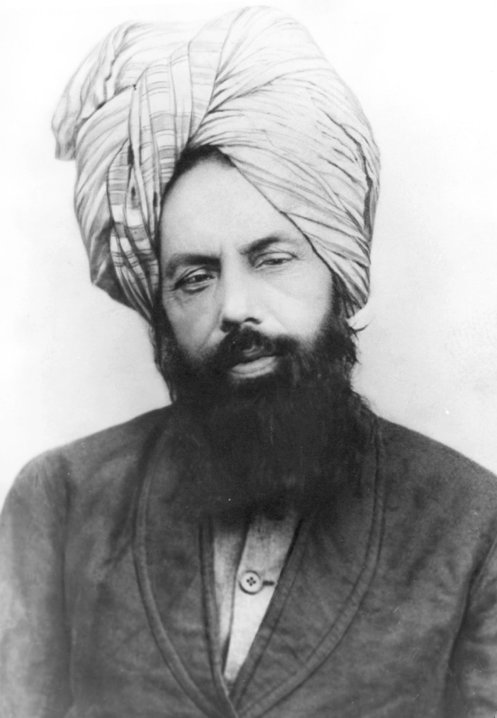
HAZRAT MIRZA GHULAM AHMAD OF QADIANas
The Promised Messiahas took his first oaths of allegiance in 1889, and continued in his unswerving defence of Islam until his death in 1908.
In 1905 he published a book warning his community of his impending demise, and comforted them with God’s promise that the community will not die with him.
In his book, ‘The Will’ he described how when Prophets come, God shows two manifestations of His Power.
The first is in the raising of the Prophet himself. The second manifestation of His Power is in the establishment of Khilafat to carry on the work of a Prophet; to prove wrong the naysayers who proclaim that a Prophet’s work will deteriorate with the Prophet’s death.
“This is what happened at the time of Hazrat Abu Bakr Siddiqra ,when the demise of the Holy Prophetsa was considered untimely and many an ignorant Bedouin turned apostate. The companions of the Holy Prophetsa, too, stricken with grief, became like those who lose their senses. Then Allah raised Hazrat Abu Bakr Siddiqra and showed for the second time the manifestation of His Power and saved Islam, just when it was about to fall, and fulfilled the promise which was spelled out in the verse [24:56] that is, after the fear We shall firmly re-establish them.
That is also what happened at the time of Mosesas, when he died on his way from Egypt to Kin‘an before taking the Israelites to the intended destination in accordance with the promise. At his death Israelites were plunged into deep mourning. It is written in Torah that with the grief at this untimely death and sudden departure of Mosesas, the Israelites wept for forty days. The same happened with Christas. At the time of the incident of Crucifixion all his disciples scattered and even one of them apostatized. So dear friends! since it is the Sunnatullah [practice of Allah], from time immemorial, that God Almighty shows two Manifestations so that the two false joys of the opponents be put to an end, it is not possible now that God should relinquish His Sunnah [practice] of old. So do not grieve over what I have said to you; nor should your hearts be distressed. For it is essential for you to witness the Second Manifestation also, and its coming is better for you because it is everlasting, the continuity of which will not end till the Day of Judgement. And that second Manifestation cannot come unless I depart.”
( The Will, Pages 6-7)
How completely were the Promised Messiah’sas words fulfilled. After his death, which certainly shook the community, his followers rallied around his most trusted and devoted disciple, Hazrat Maulana Nooruddin. After this Khalifa’s death, the Promised Messiah’s own son, the revolutionary Hazrat Mirza Bashirruddin Mahmud Ahmad was chosen as Khalifa. After his death, the cycle continued. Since the time of the Promised Messiah, there has existed an unbroken chain of Khilafat to lead this unique community, now in the fifth iteration of its Spiritual Leadership.

How is a Khalifa chosen? Ahmadi Muslims believe that a Khalifa is chosen by God Himself, who enacts his will through a committee of righteous believers. These believers constitute the Electoral College, a board of members selected from the life devotees of the community. At the death of a Khalifa, they meet as an emergency within three days. At this meeting, prior to which and during which absolutely no canvassing is allowed, names for the next Khalifa are proposed and seconded as deemed appropriate. There is then a vote on the names. Whoever is chosen is elected Khalifa for life, a great shock to the individual, and a great comfort to the community.
Is then the selection of a Khalifa just like any other democratic election? Ahmadis believe not, instead deeming the election an instantiation of God’s will. There are countless testimonials of how God guided the members of the electoral college to choose His desired candidate. These are collected most recently in the book, Dreams Foretelling the Fifth Khilafat, which focusses on the Khilafat of Hazrat Mirza Masroor Ahmadatba. We present two testimonials of the dozens collected below:

MUHAMMAD SHARIF ODEH, AMEER OF KABABIR, PALESTINE.
Mr Muhammad Sharif Odeh, Ameer of Kababir, Palestine, in his letter dated May 28, 2005 writes (the original letter is in Arabic, this translation is from its Urdu rendering):
“In May 2002 I recommended to a Palestinian friend (Amjad Kameel) that he should participate in the Jalsa Salana of UK of that year. He said that he would let me know after istikharah on this matter.
A few days later he told me that in a dream he sees himself in London and is meeting the Khalifa but instead of Hadhrat Mirza Tahir Ahmad Sahib, some other person is the Khalifa. He proceeded to describe him as having a short beard, and described his eyes etc. I told him that I did not want to know, but understood it to be an indication of the demise of Hadhrat Khalifatul Masih IVrh. Soon I forgot all about it. In April 2003 when Hadhrat Khalifatul Masih IVrh passed away I was informed over the telephone by Mr Ataul Mujeeb Rashid about my membership in the Khilafat Committee. I was very nervous given the gravity of this task and involved myself in much prayer. When we reached London, and before the election were lined up for entering the mosque for the Maghrib and Isha Prayers I happened to look behind me and saw the individual whom I had the intention to vote for. I felt it inappropriate to be standing ahead of him so I left my spot and went to the rear. At that moment two individuals arrived, one was Chaudhary Hameedullah Sahib, and the other person I did not know. But his sight much impressed me and affected my heart like a current. I started wondering as to who was this person? I was so deeply moved with this thought that I doubted my very ability to survive.
During the election proceedings I saw Mirza Masroor Ahmad and recognized him as the same person whose sight had touched my heart so profoundly. I raised my hand to vote for him and noticed that the majority had voted for him as well. At this my sentiments of deep anguish was suddenly lifted and I felt such happiness as I have never felt in all my life. Upon my return to Palestine I met Mr Amjad Kameel at the home of Mr Hani Tahir. He did not have MTA in his home and had not yet seen the picture of Hazoor. During that meeting I showed him the photograph of Hazoor, upon seeing it he blurted out that this was the same person he had seen in his dream. Even the coat and the chair were the same! I say to the doubters that if Allah does not appoint the Khalifa, then who showed Mr Amjad Kameel his image, and who is the one that made me leave my spot in the lines and led me to the rear where I saw the face which moved me so deeply, a person that was totally unknown to me?”
Mr Muhammad Ameen Johar, Ameer Mauritius wrote a letter to Huzur dated April 24, 2003. The original letter is in English (this is re-translated from its Urdu rendering):
“On the night of Saturday I was on my way to London on an Air Mauritius flight. I was praying for help and guidance. Between 1 and 4 am, while still in flight I made eight units of the pre-dawn prayer. Thereafter, I was resting, when the word ‘Masroor’ came to my lips. At that time I was convinced that this was a guidance from Allah. I was not much familiar with Hazoor at that time. I had read some reports on his activities as the Nazir-e-Ala and Ameer Muqami. When departing from Mauritius, I had someone else in mind though I had not shared it with anyone else. When I reached London I noted ‘Masroor’ on a scrap of paper and the time and circumstance when it had occurred to me. I sealed it inside an envelope and handed it to Sadr Khuddam-ul-Ahmadiyya for safe keeping until after the election. This letter was in his possession at the time of election at the London Mosque and had not been opened. In fact he had no idea to its contents. After the election and the Bai’at, when we were given permission to disperse I went to him and asked him to open the envelope and see its contents. He was much delighted and surprised to see the name ‘Masroor’ on the paper inside. It is still in his possession and he can bear witness to this matter.”
Thus we see that the election of a Khalifa at the hands of men is really just the selection of a Khalifa at the Hand of God. The divinely appointed Khalifa guides the community by divine instruction and spiritual insight through the turbulent waters of world events.
Terminology
- Khalifa – an anglicised transliteration of an Arabic word meaning the Successor to a Prophet who acts as spiritual leader of a divine community
- Khulafa – an anglicised transliteration, indicating the plural ofKhalifa
- Khalifatul Masih – the formal title of the Khulafa of the Ahmadiyya Muslim Community, literally meaning ‘Khalifa of the Promised Messiah’
- Maulana – a title indicating a learned scholar
- Jama’at – used to signify the Ahmadiyya Muslim Community in this context
- Hazrat – an Urdu version of an Arabic word, signifying the honorific His Holiness
- Huzur – an affectionate term indicating His Holiness
- Masjid – mosque
Maulana Hakeem Nooruddin
Family Background
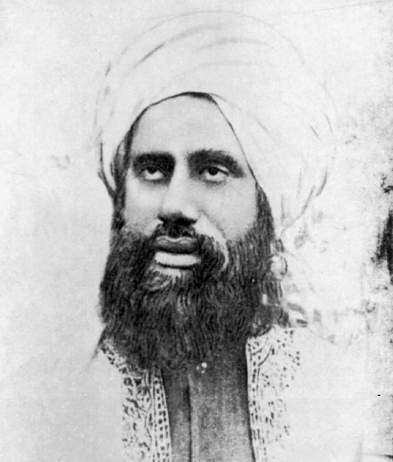
Hazrat Maulana Hakeem Nooruddinra was the first successor of the Promised Messiahas. He was born in 1841 at Bhera, Punjab, which is now a part of Pakistan. His father’s name was Ghulam Rasool and mother’s name was Noor Bakht.
His lineage can be traced back to Hazrat ‘Umar Bin Khattaabra. His family, from the very beginning, had an immense love for the Holy Qur’an, which Maulana Nooruddinra had fully inherited.
Education
He learned the Holy Qur’an from his mother, and received his general education from public schools in Lahore and Rawalpindi. His academic record was excellent and soon he was appointed as headmaster of an English School in Pind Dad Khan. After only four years he left his job and his quest for knowledge took him all over India. At the age of 25, he travelled to the cities of Mecca and Medina. There, he studied Hadith and performed Hajj. Throughout his journey, he would meet renowned teachers and saints to further his learning. Then, he himself matured into a learned scholar of Qur’anic studies, languages and natural medicine.
His Profession
On his return from Arabia, he established a school of Qur’anic studies, and started a clinic that offered treatment in natural medicine. His main objective was to serve his countrymen and spread the Qur’anic teachings. At the age of about 40 years, during a journey of one month, he memorized 14 parts of the Holy Qur’an and later on became a Hafiz by memorizing the entire Qur’an. God had given him a miraculous healing power and his prayers were abundantly accepted. People from remote corners of India started visiting him for treatment. When the Maharajah of Kashmir heard of his fame, Maulana Nooruddinra was appointed as his court physician.
The First Person to Take Bai`at (Initiation) – March 23, 1889
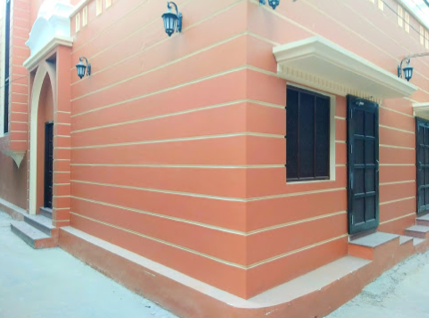
For the first time, he heard of Hazrat Mirza Ghulam Ahmadas from a person named Sheikh Ruknuddin of District Sarghoda. Then, probably before March, 1885, a Hindu fellow passed on to him an announcement published by the Promised Messiahas. This impressed him very deeply.
Soon after, he went to see Hazrat Mirza Ghulam Ahmadas in Qadian, who had not yet made any proclamation about himself. But Hazrat Maulana Nooruddinra, at the very first sight of him, recognized the truth which he personified and became his most devoted companion.
Later, on March 23, 1889, when the Promised Messiahas, accepted the first ever Bai`at (Initiation) in Ludhiana, Maulana Nooruddinra was the first person to take Bai`at.
Settlement in Qadian (April, 1893)
Soon after his first visit to Qadian, he offered to leave his job and settle in Qadian, but the Promised Messiahas did not accept his request at that time. Therefore, he stayed in Kashmir up to September 1892, when the new Ruler of Kashmir terminated his job. He now returned to Bhera and started the construction of a large clinic. In April 1893, the construction of his clinic was near completion. He went to Qadian on a short visit. But when the time came for him to take leave, the Promised Messiahas asked him to forget about his hometown and make Qadian his permanent home. So he stayed and from that moment on, he never even thought of returning to Bhera. Such was his complete submission and obedience to the Promised Messiahas.
His Life in Qadian
He established a clinic in Qadian and started giving free treatment to the poor. He fully enjoyed the company of the Promised Messiahas and dedicated his life to the cause of his mission. He taught the Holy Qur’an and Ahadith to the children of the Promised Messiahas and to hundreds of other students. He served as a teacher in Arabic in the Ta`leemul Islam High School. He was appointed President of the Sadr Anjuman Ahmadiyya, Qadian. He contributed to the newspapers Al-Hakam and Al-Badr and completed a translation of the Holy Qur’an.
His Khilafat (May 27, 1908 to March 13, 1914)
After the sad demise of the Promised Messiahas, Hazrat Maulana Nooruddinra was elected as first Khalifa. On that occasion, nearly 1,200 members of the Jama`at took Bai`at at his hands. The first and foremost task performed by him, was the consolidation of the system of Khilafat. Some of the important events of his Khilafat are as follows:
- On May 30, 1908, Baitul Maal or the Treasury was set up. On March 5, 1910, Huzur laid the foundation-stone of Masjid Noor.
- On March 1, 1909, Madrasa Ahmadiyya was opened, replacing the Branch of Religious Education which was previously opened (January 1906) in Madrasa Ta`limul Islam, Qadian. The purpose of this branch was to produce missionaries according to the instructions of the Promised Messiahas. The same Madrasa Ahmadiyya progressed and eventually became Jamia Ahmadiyya on May 20, 1928 during the time of Hazrat Khalifatul Masih IIra.
- On November 18, 1910, Huzur fell down from his horse and received a serious head injury. The Promised Messiahas had seen this event take place in a dream in 1905.
- In February 1911, Anjuman Ansarullah was set up by Hazrat Mirza Bashiruddin Mahmood Ahmadra. On July 25, 1912, Hazrat Khalifatul Masihra I laid the foundation stone of Ta`leemul Islam High School.
- On June 19, 1913, the newspaper Al-Fadl was published for the first time. In the same month, the first foreign mission was established in England.
- On December 26-28, 1913, he delivered two magnificent lectures in the Jalsa Salana, which turned out to be the last Jalsa Salana of his Khilafat.
His Illness and Demise (March 13, 1914)
In January 1914, Huzurra fell seriously ill. His health continued to decline as the time passed. But his religious activities, particularly his Dars-e-Qur’an, were not interrupted. On the 13th of March, 1914, the last Friday Prayer of his Khilafat was led by Hazrat Mirza Bashiruddin Mahmood Ahmadra. The same day, at 2:20 p.m, Hazrat Khalifatul Masih Ira passed away, while he was saying his prayer.
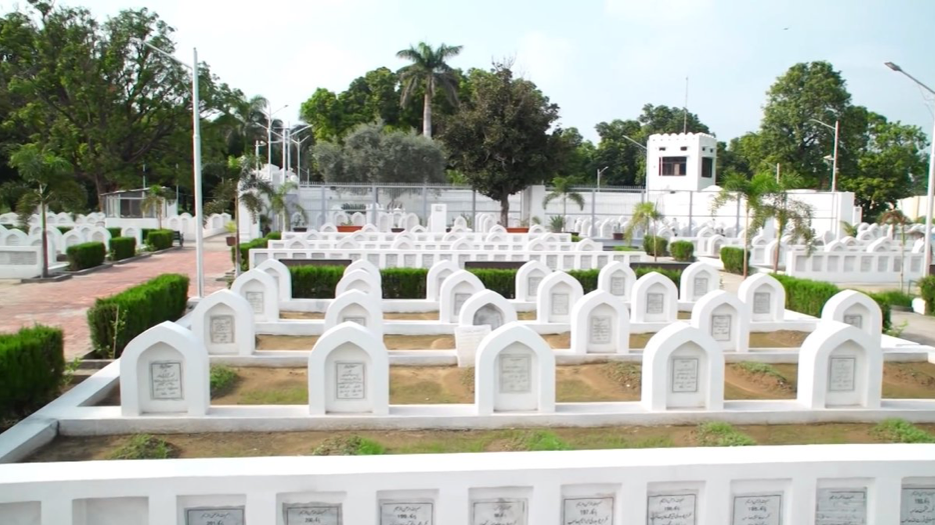
The next day, Hazrat Mirza Bashiruddin Mahmood Ahmadra was elected Khalifatul Masih II (‘Khalifa of the Messiah, the 2nd) , who led the funeral prayer of this blessed person. He was buried in the Heavenly Graveyard by the side of his beloved Imam, the Promised Messiahas.
Hazrat Maulana Nooruddinra enjoyed a unique status because of his love for the Holy Qur’an and the Promised Messiahas. Also, his complete trust in God, high standard of righteousness and his grand service to humanity, were the three distinctive qualities of his character.
The Promised Messiah’s great love and regard for him is beautifully expressed in one of his Persian poems as follows:
“How wonderful would it be if everyone among my followers were to become Nooruddin. It can happen only if every heart is filled with the light of certainty of Faith.”
There are two available English biographies of the Hazrat Khalifatul Masih I – The Way of the Righteous, by Syed Hasanat Ahmad, and Hazrat Maulvi Nooruddin – Khalifatul-Masih I by Sir Muhammad Zafrullah Khanra.
This page is an excerpt from the book ‘Basics of Religious Education’ by Sheikh Abdul Hadi, with very minor amendments.
Mirza Bashirruddin Mahmud Ahmad
His Birth – A Sign of God (January 12, 1889)
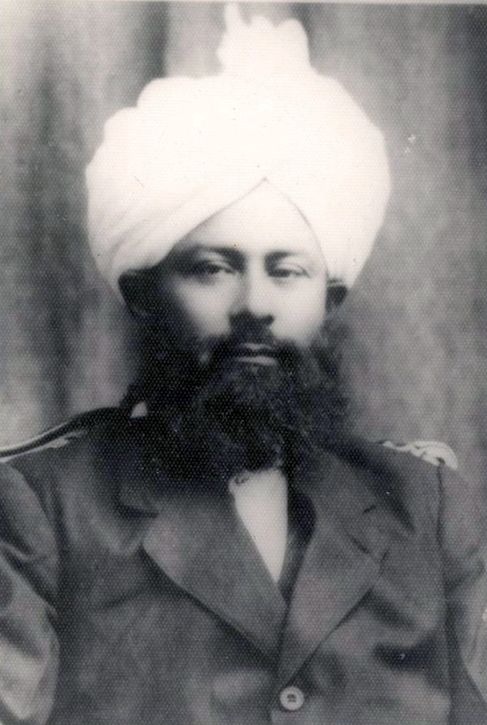
Hazrat Mirza Bashiruddin Mahmood Ahmadra was the second successor of the Promised Messiahas. He was a distinguished Khalifa because his birth was foretold by a number of previous prophets and saints. Moreover, the Promised Messiahas received revelation foretelling a Divine Sign for the truth of Islam as a result of his forty days’ prayers at Hoshiarpur (India).
God Almighty told him that a pure son would be born to him within a period of nine years. He had already published this prophecy regarding Muslih Mau`ood (the Promised Reformer) on February 20, 1886.
In accordance with this divine prophecy and within the specified period, the promised son, was born to the Promised Messiahas on January 12, 1889 at Qadian. He was named Bashiruddin Mahmud Ahmad. The prophecy about Muslih Mau`ood had also specified some special qualities of the promised son. For instance, it was foretold that he would be extremely intelligent and highly learned. His fame will spread to the ends of the earth and nations would be blessed through him. Let us now study brief a short account of his life and see how magnificently this grand prophecy was fulfilled in the person of Hazrat Mirza Bashiruddin, known as Khalifatul Masih-IIra, i.e. the 2nd Khalifa of the Messiah.
Education and Early Years
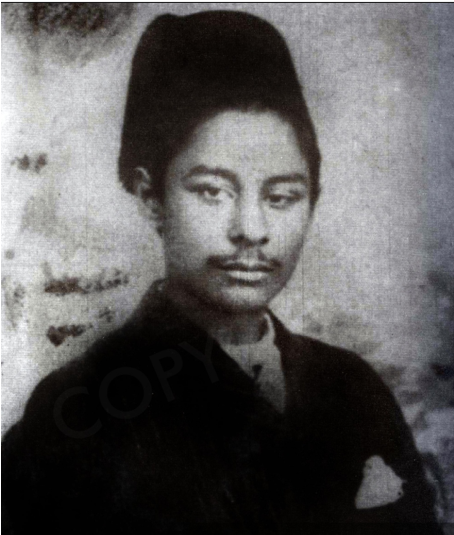
He received his primary education in a school of Qadian and then in the Ta`leemul Islam School when it started in 1898. He could not do well in his studies due to his persistent ill- health. His academic career came to an end in March 1905, when he failed in the Matriculation (Grade 10) examination. About two years before this, in October 1903, he had married Sayyidah Mahmooda Begum Sahiba.
He started learning the translation of the Holy Qur’an and the Ahadith from Hazrat Maulana Nooruddinra. Moreover, he began his independent study of religion, history, literature and various other subjects. He developed into a great scholar and had mastery over many subjects.
Thus, the following prophecy of the Promised Messiahas regarding Muslih Mau`ood was clearly fulfilled in his person:
“He will be extremely intelligent and understanding and will be meek of heart and will be filled with secular and spiritual knowledge.”
Beginning of Revelations (1905)
He received his first divine revelation in 1905, when he was only sixteen years old:
“I will place those who follow you above those who disbelieve until the day of Resurrection.”
In 1907, he said that an angel taught him the commentary of Surah Fatihah, the first chapter of the Holy Qur’an. From then onward, he was gifted with an unusual knowledge of the commentary of the Holy Qur’an.
When the Promised Messiahas passed away, Hazrat Muslih Mau`oodra was only nineteen years old. On this critical occasion, he stood by the body of his deceased father and made the following pledge: “Even if all the people should abandon you, I will stand alone against the whole world, not caring for any opposition or enmity.”
In September 1912, he performed the pilgrimage to Mecca. In 1913, he started the publication of the newspaper Al-Fadl.
His Election as Khalifatul Masih II (March 14, 1914)

On March 14, 1914, the day after the death of Khalifatul Masih Ira, Hazrat Mirza Bashiruddinra was unanimously elected as Khalifatul Masih II, when he was only 25 years old. About 2,000 Ahmadis present at that occasion, took Bai`at at his hands.
There was a small but influential group of opponents within the community, who did not take the Bai`at. At first, they tried their best to put an end to the system of Khilafat. Then, they decided to leave Qadian and moved to Lahore. They were certain that the young Khalifa would not survive without their support, and the system of Khilafat would collapse by itself. Their expectations, however, turned out to be completely wrong. The followers of the young Khalifatul Masih grew rapidly, whereas his opponents were reduced to an insignificant group. The blessings of Khilafat prevailed.
His Khilafat (March 14, 1914 to November 8, 1965)
Under the great leadership of Hazrat Khalifatul Masih IIra, the Ahmadiyya community progressed by leaps and bounds. His 52-year long period of Khilafat was full of unusually great achievements and landmarks that demonstrated Divine help.
From the very first day of his Khilafat, he started taking all necessary steps to organize and unite the community. Soon the crisis was over and stability prevailed. Then, the young Khalifa began making elaborate plans for the spread of Islam throughout the world. Some highlights of his achievements are given below:
- On April 12, 1914, the first Majlis-e-Shoora (consultative committee) of his Khilafat took place, to formulate a worldwide Tabligh Plan. On December, 1915, the commentary of the first part of the Holy Qur’an was published.
- On January 1, 1919, various Departments (Nazaarats)were set up to streamline the working of Sadr Anjuman Ahmadiyya.On April 15, 1922, the Majlis Shoora was established for the first time, as a permanent advisory body to the Khalifa.
- On September 23, 1924, he attended the Wembley Conference in England, where his article ‘Ahmadiyyat – The True Islam’ was read out. On May 20, 1928, he inaugurated Jamia Ahmadiyya, an elite institution for training and producing qualified Muslim missionaries.
- On December, 1930, his elder brother, Hazrat Mirza Sultan Ahmadra took Bai`at, the initiation, at his hands and became the fourth Ahmadi son of the Promised Messiahas. Thus, the part of the prophecy regarding Muslih Mau`ood, He will convert three into four was fulfilled.
- On July 25, 1931, he was elected president of the All-India Kashmir Committee, and strived hard for the rights of the Kashmiri people. Later on, in June 1948, he sent a battalion of Ahmadi volunteers called Furqaan Force to fight along with the Pakistan Army for liberating Kashmir.
- He wrote a large number of books, including ten volumes of the Tafseer-e-Kabeer, the detailed commentary of the Holy Qur’an.
In addition, some of his other achievements are summarized below:
Establishment of Foreign Ahmadiyya Missions
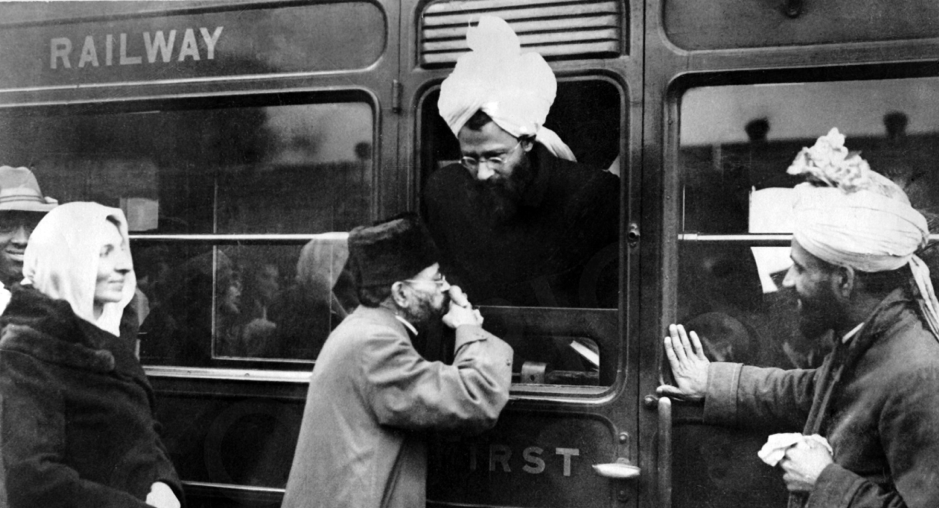
Many new Ahmadiyya missions were opened in a number of foreign countries such as: Ceylon and Mauritius (1915), U.S.A (1920), West African countries (1921), Indonesia (1925) and Palestine (1928). The Fazl Mosque, London was founded on October 19, 1924 by Hazrat Khalifatul Masih II himself.
Tahrik-e-Jadid (November 23, 1934)
To intensify the missionary work in foreign countries, a new scheme named, Tahrik-e-Jadid, or The New Scheme, was initiated, which was based on observing nineteen principles or demands. Under this scheme, Ahmadis were urged to lead a simple life and to make more sacrifices of their time and money for the cause of Islam. Also, they were advised to earn more and to ensure higher education for their children.
As a result of this innovative scheme, more foreign missions were opened in many other countries such as: East Africa (1934), Japan (1935), Burma (1938), France (1945), Spain (1946), Holland (1947), Switzerland (1948), West Germany (1949) and Denmark (1956). Later on, a number of missions were opened in Sweden, Norway, Fiji and Guyana.
Auxiliary Organizations
As the community was growing rapidly, it was divided into different age groups to ensure better training of all Jama`at members:
- Lajna Imaa’illah: for women above the age of 15- established on December 25, 1922.
- Nasiratul Ahmadiyya:for girls of ages 7 to 15 years established in February, 1939. Majlis.
- Ansarullah: for men above the age of 40-established on July 26, 1940 — Hazrat Maulvi Sher Ali was the first president. Majlis Khuddam-ul-Ahmadiyya: for the youth of ages 15 to 40-established on December 25, 1938.
- Majlis Atfalul Ahmadiyya:for boys for 7 to 15 years of age- established on July 26, 1940.
Claim to be The Promised Reformer (January 28,1944)
On January 28, 1944, Hazrat Khalifatul Masih IIra claimed for the first time that he was indeed the ‘Promised Son’ as mentioned in the prophecy regarding Muslih Mau`ood. In a number of public meetings, he told the community that his claim was based on various divine revelations and dreams. These meetings were held in Hoshiarpur (Feb. 20, 1944), Lahore (March 12, 1944), Ludhiana (March 23, 1944) and Delhi (April 16, 1944).

New Centre at Rabwah (September 20, 1948)
In August, 1947, when Pakistan came into being, Hadhrat Khalifatul Masih IIra along with the Jama`at members moved from Qadian to Pakistan. Some 313 Ahmadis, called Darveshaan stayed behind to take care of Qadian.
In Pakistan, Huzurra laid the foundation of Jama`at’s new Centre at Rabwah, a waste and barren piece of land, which has wonderfully transformed into a model town with all its religious, educational and social institutions. In addition, there are the headquarters of the worldwide Ahmadiyya Muslim Jama`at, and the official residence of the Khalifatul Masih, called Qasre-Khilafat. It would be of interest to note that the Arabic word Rabwah means ‘an elevated land’ and is mentioned in the Holy Qur’an (23:51) with reference to Jesus Christas and his mother.
Waqf-e-Jadid (1957)
On December 28, 1957, Huzurra announced this novel plan to expand missionary work to educate and impart religious training to rural population inside Pakistan.
Murderous Attempt on his Life & Visit to Europe (March 1954)
On March 10, 1954, Hadhrat Khalifatul Masih IIra survived an attempt on his life, but he was seriously wounded in his neck. This happened in Masjid Mubarak, Rabwah, at the time of the late afternoon prayer. As soon as he got up to leave after the Prayer, an enemy of Ahmadiyyat, who had come to the mosque with an intention to kill him, moved forward and stabbed Huzur in the side of his neck from behind. It was a deep wound but God saved the life of Huzur. Later on, he had to go to Europe on April 5, 1955, for medical treatment.
In Europe, Huzurra remained very busy with the inspection of foreign missions, and the duties of his office, and thus recovered only partially. He came back to Rabwah on Sept. 25, 1955. He was again fully occupied with the heavy duties of his office. In addition, he completed the writing of Tafseer-e-Sagheer, the short commentary of the Holy Qur’an, in 1957.

Fazl-E-Umar
Mujeebur Rahman
A new biography of the Promised Reformer, delving deep
into his life and literature. A must-read to learn about this Man of God.
Read it now.
His Illness and Demise (Nov. 8, 1965)
As a result of his extremely heavy work load and the after-effects of the deep wound in his neck, his health condition gradually worsened over a period of seven years. At last, on November 8, 1965, at nearly 2 a.m., before dawn, Hadhrat Muslih Mau`ood, Khalifatul Masih II, passed away, at the age of seventy-seven.
Next day, his funeral prayer was led by Hadhrat Mirza Nasir Ahmadra, the newly elected Khalifatul Masih IIIrh. He was buried in the Heavenly Graveyard by the side of his blessed mother.
He possessed a unique combination of qualities of leadership, organizational genius, trust in God, courage, depth of knowledge in many fields and personal magnetism. No doubt, his 52-year long Khilafat represented a golden period in the History of Ahmadiyyat. And, in his person the prophecy regarding Muslih Mau`ood was fulfilled with great perfection.
You can read the 26 books of the 2nd Khalifara translated into English here.
The above page had been extracted from the book ‘ Basics of Religious Education’ by Sheikh Abdul Hadi, with some amendments.
Mirza Nasir Ahmad
His Early Life
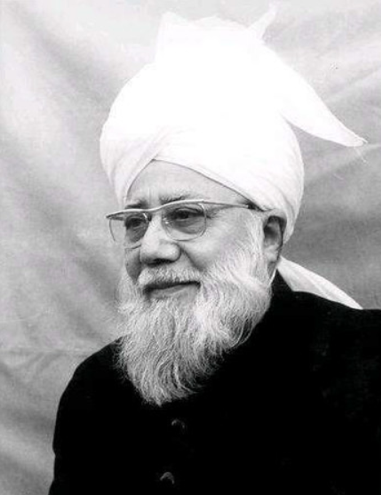
Hazrat Mirza Nasir Ahmadra, the third Khalifa of the Promised Messiahas was born on November 16, 1909. He was the son of Hazrat Khalifatul Masih IIrh and grandson of the Promised Messiahas. His birth was foretold by God Almighty in a revelation to the Promised Messiahas:
‘I shall give you a boy who will be your grandson.’
Similarly, his father, Hazrat Khalifatul Masih IIra was told by God Almighty that He would be given a son:
…who will be `Nasir’ or Helper of Religion.’
Education
Hazrat Mirza Nasir Ahmadrh became a Hafiz at the age of thirteen, when he completed memorization of the Holy Qur’an. In July 1929, he obtained the degree of Maulvi Faadil (Religious Scholar), from Punjab University. In 1934, he graduated from Government College, Lahore.
He married in August 1934. One month later, he left Qadian for England for higher studies. In November 1938, he came back to Qadian after obtaining his Masters degree from Oxford University.
His Services to the Community
Soon after his return from higher studies, Hazrat Mirza Nasir Ahmadrh started serving, first as a professor and then, from 1939 to 1944, as Principal, of Jamia Ahmadiyya Qadian, the Ahmadiyya Missionary University. He then served as a Principal of the Secondary School in Rabwah, before being president of the men’s youth association. Soon after he also became president of the Older Men’s Association. Finally in 1950 he was chosen to head the Sadr Anjuman Ahmadiyya, a criticial administrative body in the Ahmadiyya Muslim Community.
His Khilafat
“This is a covenant, which I have made knowing that God is One and is Omnipotent and Omnipresent and He knows the Unseen, and cursed is he who behaves fraudulently at this hour. I promise before you all that I shall try my best to convey the divine message of Islam in the whole world, and treat everyone of you with love and sympathy.
As you have put heavy burden of responsibility on my shoulders, I expect that you will assist me with prayers and sincere advice that Allah may take such work from me, which is essential for the propagation of Islam and Ahmadiyyat…”
– From Hazrat Mirza Nasir Ahmad’sra first speech
On November 8, 1965, Hazrat Khalifatul Masih IIra passed away in Rabwah, Pakistan. Thereupon, Hazrat Mirza Nasir Ahmadrh was elected as Khalifatul Masih III. Following his election, some five thousand present Ahmadis, performed Bai`at at his hands. Some of the salient features of his seventeen-year Khilafat are given below:
Fadl-e-`Umar Foundation (1965)

Hazrat Khalifatul Masih IIIrh established this scheme in memory of the 2nd Khalifara. The Jama’at contributed 5.2 million rupees, much in excess of the target of 2.5 million initially fixed by Huzur.
This fund was used to promote activities which had been of special interest to Hazrat Khalifatul Masih IIra, in the fields of research work, education, missionary work and economic welfare of the Jama’at. Under this scheme, on October 3, 1971, a modern library named Khilafat Library was also established in Rabwah. You can see its online portal here.
Nusrat Jehan Scheme (1970)
During his visit (from April 4 to June 8, 1970) to seven countries of West Africa,‘Nusrat Jehan Scheme’was announced by Huzur, which he announced soon after his return to Rabwah. It was named after Hazrat Ummul Mu’mineen, Sayyidah Nusrat Jehanra, the wife of the Promised Messiahas.
Under this scheme, Huzur appealed to raise a fund of £100,000 and to organize a large group of volunteer teachers and doctors for the establishment of a number of hospitals and schools in West Africa, purely for the service of humanity and without any profit motive.
The Jama’at responded to Huzur’s appeal in an exemplary manner and, in a short span of time, 17 Medical Centres and 15 Secondary Schools were established in West African countries.
Centenary Jubilee Scheme
On the last day of Jalsa Salana 1973, Hazrat Khalifatul Masih IIIrh announced this grand scheme, not only to mark the 100 years of existence of the Ahmadiyya Muslim Jama’at on March 23, 1989, but also to plan an intensive program to be undertaken during the next century for spreading Islam. Under this scheme, Huzurrh appealed to raise a fund of 25 million rupees in sixteen years (1974-1989) to expand the project of foreign missions and translations of the Holy Qur’an, and to install printing presses and broadcasting systems. By the grace of God Almighty, Jama`ats from more than fifty-four countries participated in this grand scheme, which in addition to other projects, resulted in the construction of a mosque in Berg, Sweden and another in Oslo, Norway. Also, five new Jama’at Centres were opened in the UK.

Hazrat Khalifatul Masih IIIra announced the scheme Waqf-e `Aardi on March 12, 1966, under which Ahmadi Muslims should spend at least two weeks of their time at a designated place, at their own expense, in teaching the Holy Qur’an and giving religious training to the local Ahmadis.
He instituted a body to help administrate the Moosiyaan, people who had devoted a high proportion of their income to the community, and who took an additional responsibility to live up to Islam’s teachings. He inaugurated Khilafat Library, Rabwah on October 3, 1971, and a new mosque in Rabwah, on March 31, 1972.
Also, he laid the foundation stone of Masjid Basharat, Spain, on October 9, 1980. On this occasion, he announced the golden Islamic motto —
Love for All, Hatred for None
Violence against Ahmadis
On May 29, 1974, with the attack on Rabwah railway station by the Nishtar College students, severe violence broke out against Ahmadis throughout Pakistan. It was backed by the then government of Pakistan headed by prime minister Zulfiqar Ali Bhutto.
Houses of Ahmadis were looted and burnt, and a number of Ahmadis were killed during these acts of violence. The community members were subjected to social boycott and many high-ranking Ahmadi civil and army officials were forcibly retired. During this critical period, the Ahmadis, under the able guidance of Hazrat Khalifatul Masih IIIrh, faced all hardships with great patience, endurance and prayers. In the end, on Sept. 7, 1974, the National Assembly of Pakistan passed an amendment to the Constitution, which declared the Ahmadis in Pakistan to be non-Muslims.
From the perspective of Ahmadi Muslims, this was undoubtedly an act of grave defiance in the sight of Allah. Consequently, prime minister Zulfiqar Ali Bhutto met with a humiliating end when he was later removed from office, imprisoned and then hanged on April 4, 1979.
His Illness and Demise
On May 21, 1982, Hazrat Khalifatul Masih IIIrh delivered his last Friday sermon. On May 23, he left Rabwah for Islamabad, where, on May 26, he was taken ill and passed away on June 9, 1982 at 12.45 p.m. On June 10, 1982, Hazrat Mirza Tahir Ahmad, the newly elected Khalifatul Masih IV (May Allah help him), led his Janazah prayer in Rabwah with nearly 100,000 participants. He was buried in theHeavenly Graveyard, Rabwah, Pakistan.
During the seventeen years of his Khilafat, Hazrat Khalifatul Masih IIIrh, with his unique administrative ability and his distinctive plans of far-reaching benefits, was certainly able to strengthen and expand the Jama`at remarkably.
You can read the translated books of the 3rd Khalifara here.
This page is an excerpt from the book ‘Basics of Religious Education’ by Sheikh Abdul Hadi, with very minor amendments.
Mirza Tahir Ahmad
Early Life
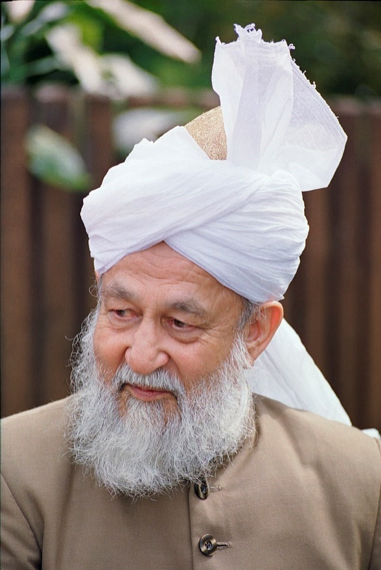
Hazrat Mirza Tahir Ahmad, Khalifatul Masih IVrh was born in Qadian on December 18, 1928. He was the son of Hazrat Mirza Bashiruddin Mahmood Ahmad, Khalifatul Masih IIra from his third wife Hazrat Sayyidah Umm-e-Tahir Maryam Begumra. His maternal grandfather, Hazrat Dr. Abdus-Sattar Shahra, was a devoted companion of the Promised Messiahas, whose lineage can be traced back to Hazrat Alira, the fourth Khalifa of the Holy Prophetsa.
Hazrat Mirza Tahir Ahmadrh obtained his high school education in 1944 at Ta`leemul Islam High School, Qadian, and then his higher secondary education from Government College Lahore.
In 1953, he obtained the degree Shahid (Religious Scholar) from Jamia Ahmadiyya, the Ahmadiyya Missionary university, Rabwah. In April 1955, he accompanied his father, Hazrat Muslih Mau`oodra, who went for a visit to England. He obtained higher education in the School of Oriental and African Studies (SOAS), London University. He returned to Rabwah on October 4, 1957.
Services to the Community
Hazrat Mirza Tahir Ahmad served in various position in the community’s organisation, helping to promote missionary activities, education, leading the youth organisation, and even serving as a member of the delegation to represent Ahmadiyyat to the National Assembly of Pakistan.
His Khilafat
After the sad demise of Hazrat Mirza Nasir Ahmad, Khalifatul Masih IIIra, Hazrat Mirza Tahir Ahmadrh was elected Khalifatul Masih IV on June 10,1982 at Rabwah, and all the participants took Bai`at at his hands.
By the end of July, 1982, Hazrat Khalifatul Masih IVrh started his visit to Europe for an inspection of the foreign missions and to inaugurate the Basharat Mosque, Pedroabad, Spain.
During this visit, Huzurrh opened two new missions in England and established consultative bodies in a number of countries. Besides conducting a large number of Majalis Irfan (question answer sessions) in each country he visited, he addressed eighteen press conferences and delivered a public lecture in Zurich, Switzerland.
On September 10, 1982, Huzurrh inaugurated the historic Masjid Basharat at Pedroabad, Spain—the first one to be built in that country in the last 500 years. The ceremony was attended by nearly two thousand Ahmadi representatives from different countries of the world and about one thousand local citizens. The proceedings of the inauguration were widely displayed by the leading newspapers, radio and television throughout Europe. In this way, the message of Islam reached millions of people in a very effective manner.
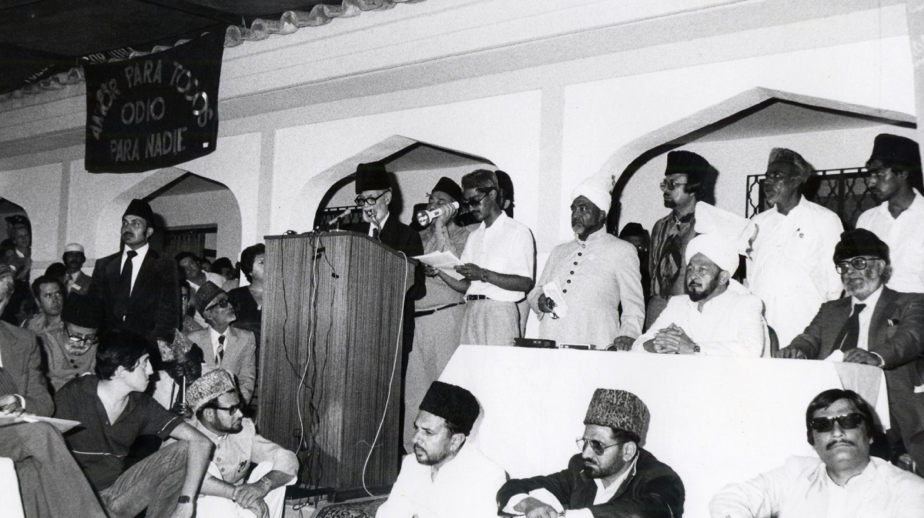
On September 30, 1983, during his visit to Australia, Huzurrh laid the foundation stone of the first Ahmadiyya Mosque at Sydney, Australia. Moreover, he launched many schemes to promote Ahmadi Muslims to dedicate their lives for the service of the community, and for humanity as a whole. One of these schemes was the Waqf-e-Jadid scheme, which sought to spread Islam across the world. Another scheme of note is the Waqf-e-Nau scheme, under which Ahmadi families were urged to dedicate their children for the service of the community. They would undergo more focused education in religious matters, before being asked to affirm or decline continued participation in the scheme at 16 years of age.
Migration to England
Despite the two major outbreaks of violence against the Ahmadis in Pakistan (1953 and 1974), the Divinely instituted Ahmadiyya movement continued its systematic progress during the periods of second and third Khilafat. In the face of grand new schemes launched by Hadhrat Khalifatul Masih IVrh, the government of Pakistan and its orthodox Islamic clergy mounted another wave of violence, persecution and severe restrictions against the Ahmadis, which culminated in Ordinance 20 on April 26, 1984. These were led by Presiden Zia-ul-Haq. As it became increasingly difficult to safeguard the institution of Khilafat in Pakistan in view of the new restrictions, Hadhrat Khalifatul Masih-IV migrated to England on April 29-30, 1984. This migration has opened a new era in the history of the Jama`at.
Challenge to Prayer Duel
Hazrat Khalifatul Masih IVrh challenged President Zia-ul-Haq of Pakistan and his supporters to a Mubahila (prayer contest). This meant that by offering prayers for God’s judgement, God would inflict His sign of wrath on the liars. Huzur also said that God would do so even if the prayer contest was not formally accepted by General Zia-ul-Haq. As a result of this prayer contest, on August 17, 1988, President Zia-ul-Haq and many of his associates died in a freak aeroplane accident, with the authorities finding no evidence of foul play, and with all parties being shocked at the inexplicable nature of the incident. For Ahmadis, this was a great sign of divine support against those who sought to persecute them. While Ahmadis will never take arms against their opponents, sometimes God Himself will demonstrate his anger at those who seek to crush the movement.
Centenary Celebrations & Qadian Conference

The completion of the first century of Ahmadiyya Muslim Jama’at was celebrated in almost all the countries of the world. In Pakistan, the Government of Punjab banned a substantial part of these celebrations.
In December 1991, Huzurrh undertook the historic trip to Qadian, India to attend the 100th Annual Conference (Jalsa Salana). It was undoubtedly a great historic event because since 1947, this was the first occasion that a Successor to the Promised Messiahas visited Qadian, the first Center of Jama`at Ahmadiyya. Thousands of Ahmadis from all corners of the world poured into Qadian, and Huzur’s speeches were televised all over the world. Hazrat Syeda Asifa Begum, wife of Hazrat Khalifatul Masih IVrh and granddaughter of the Promised Messiah, despite her illness, accompanied Huzur on his trip to Qadian. She passed away on April 3rd, 1992 in London.
MTA (Muslim Television Ahmadiyya)
On August 21, 1992, previous trial satellite transmissions were organized into the blessed system of Muslim Television Ahmadiyya (MTA).
- On October 16, 1992, Huzurrh inaugurated the Bai’tul Islam Mosque (Toronto, Canada), then the largest mosque in North America, with the Friday Sermon. It was an unprecedented event — for the first time in the history of Ahmadiyyat and Islam, a Friday sermon was transmitted live to all continents of the world, thus fulfilling the revelation of the Promised Messiah—I shall cause thy message to reach the corners of the earth —in an entirely new way.
- On October 14, 1994, another historic event took place. Huzurrh simultaneously inaugurated Baitur Rahman Mosque in Washington D.C and the Jama`at’s first satellite earth station. This station serves the Western Hemisphere by relaying the international transmission from the UK. On April 1, 1996, 24-hour worldwide MTA service was started.
Through MTA, Huzurrh launched various programmes of Q&A with English, Arab, French, Bengali guests and more. He broadcasted his sermons, his children’s classes, his medicinal lectures, and much else besides. MTA was truly a revolution in Islamic broadcasting.
But Huzur’s work was far from over. In 1993 he launched an appeal to help the oppressed Bosnian people, raising £79,000 for their aid. In 2000, he made a historic visit to Indonesia, the largest Islamic country in the world, delivering a lecture and taking questions from leading intellectuals. Also in that year, based on a divine dream he saw, he drew the attention of the community to the problems of unemployment and arrangement of marriages of young children. He was to fulfil this fervent desire of this more fully in launching the Maryam Shaadi Marriage fund to provide financial help to needy parents for the marriages of their daughters.
Nearing the End of His Khilafat
In July, 2002, Huzurrh addressed the last Annual Conference (63rd Jalsa Salana) of his Khilafat in U.K. In his address on the second day (July 27), Huzurrh presented an account of stunning achievements during his Khilafat.
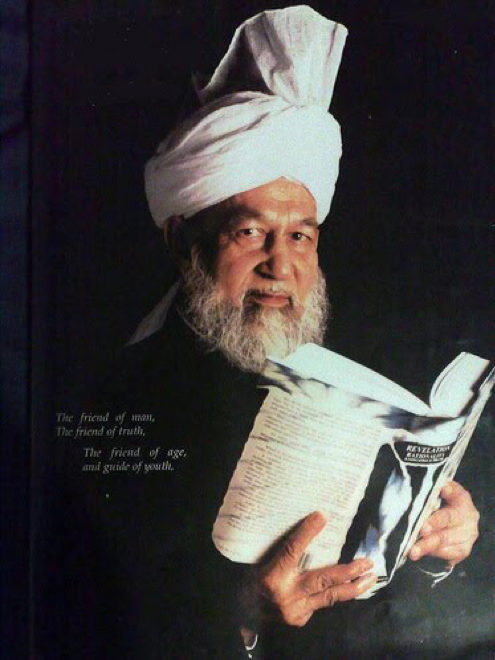
After his migration to United Kingdom in 1984, an addition of 13065 new mosques and 985 new missions took place in various countries of the world. The up-to-date translations of the Holy Qur’an increased to 56 and the Translations of Selections from the Holy Qur’an increased to more than 100. Since 1984, Jama`at Ahmadiyya was established in 84 additional countries of the world and thus on the whole, Jama`at Ahmadiyya has been established in 175 countries of the world.
He passed away on April 19th of 2003, a day after a final Friday sermon explaining prophecies of the Holy Qur’an, the Prophet Muhammadsa and the Promised Messiahas. Thus departed an exceptionally gifted person blessed with an ocean of secular and Qur`’anic knowledge. He had developed exceptional skills in studying scientific research in light of the Holy Qur’an. This was clearly demonstrated when he published his famous book, named, ‘Revelation, Rationality, Knowledge and Truth’ published in 1998. Under his 21 years of vibrant and dynamic leadership, the community progressed by leaps and bounds. He was accessible to the masses through his extensive world-wide tours, hundreds of question-answer sessions in public and on Muslim Television Ahmadiyya. In addition to his religious and spiritual duties, he served the community as a great homeopathic physician, a prolific writer and a keen sportsman.
You can read the English literature of the 4th Khalifa here.
This page is an excerpt from the book ‘Basics of Religious Education’ by Sheikh Abdul Hadi, with minor amendments.
Mirza Masroor Ahmad
Personal Biography

His Holiness was born on 15th September 1950 in Rabwah, Pakistan to the late Mirza Mansoor Ahmad and the late Nasira Begum Ahmad. Upon completing his Masters Degree in Agricultural Economics in 1977 from the Agriculture University in Faisalabad, Pakistan, His Holiness formally dedicated his life to the service of Islam.
From 1977 to 1985, His Holiness served in Ghana, engaged in social, educational and agricultural development projects. He is accredited with successfully growing wheat on Ghanaian soil for the first time in the nation’s history. His Holiness returned to Pakistan in 1985 and served in various senior administrative posts within the Community during the next 18 years, including as Chief Executive of the Ahmadiyya Muslim Community in Pakistan from 1997 until his election as Khalifa.
His Holiness resides in London, UK with his wife, Amtul Sabooh Ahmad. He has two children and three grandchildren.
His hobbies include gardening, reading, photography and walking.
Khilafat

His Holiness Mirza Masroor Ahmad, is the fifth Khalifa (Caliph) of the Ahmadiyya Muslim Community. Elected to this lifelong position on 22nd April 2003, he serves as the worldwide spiritual and administrative head of an international religious organisation with membership exceeding over 10 million, spread across over 206 countries.
Peace Initiatives
His Holiness is the world’s leading Muslim figure promoting peace and inter-religious harmony. Through his sermons, lectures, books, and personal meetings, His Holiness has continually advocated the worship of God Almighty and serving humanity. He also continually advocates for the establishment of universal human rights, a just society and a separation of religion and state.
Since being elected Khalifa, His Holiness has led a worldwide campaign to convey the peaceful message of Islam, through all forms of print and digital media. Under his leadership, national branches of the Ahmadiyya Muslim Community have launched campaigns that reflect the true and peaceful teachings of Islam. Ahmadi Muslims the world over are engaged in grassroots efforts to distribute millions of ‘Peace’ leaflets to Muslims and non-Muslims alike, host interfaith and peace symposia, and present exhibitions of The Holy Qur’an, to present its true and noble message. These campaigns have received worldwide media coverage and demonstrate that Islam champions peace, loyalty to one’s country of residence and service to humanity.
In 2004, His Holiness launched the annual National Peace Symposium in which guests from all walks of life come together to exchange ideas on the promotion of peace and harmony. Each year the symposium attracts many serving ministers, parliamentarians, politicians, religious leaders and other dignitaries. In 2009, His Holiness also launched the annual ‘Ahmadiyya Muslim Prize for the Advancement of Peace‘; an international peace award for individuals or organisations that have demonstrated an extraordinary commitment and service to the cause of peace and humanitarianism.
In 2012, both the United States Congress and the European Parliament benefited directly from His Holiness’s message of peace, justice and unity.

On 27 June 2012, Hazrat Mirza Masroor Ahmad was welcomed to Capitol Hill in Washington D.C. where he delivered a keynote address entitled, ‘The Path to Peace – Just Relations between Nations’, to an audience filled with more than 30 members of the United States Congress. In conjunction with this historic event, a bi-partisan resolution was introduced in the House of Representatives in honour of His Holiness’s visit.
On 4 December 2012, His Holiness delivered a historic keynote address at the European Parliament in Brussels to a packed audience of more than 350 guests representing 30 countries, including the President of the European Parliament. During his thirty-five minute address, His Holiness called on the European Union to preserve its unity and called for equality and justice in international relations.
On 11 February 2014, His Holiness delivered the keynote address at ‘The Conference of World Religions’ held at the Guildhall in London. During his address, His Holiness outlined Islam’s commitment to promoting mutual understanding, tolerance and respect based on the teachings of the Holy Quran and the life of the Holy Prophet Muhammad (peace be upon him).
Public Service
His Holiness has travelled globally to promote and facilitate service to humanity. He regularly meets presidents, prime ministers, other heads of state, parliamentarians and ambassadors of state.
- Keynote Address at Capitol Hill: Video | Text
- Keynote Address at the EU Parliament: Video
- Keynote Address at the Montage Hotel: Video | Text
- Keynote Address in the Houses of UK Parliament: Video
His Holiness takes a particular interest in alleviating the suffering of developing nations, by helping to improve their agriculture and facilitating access to food, clean water and electricity. He oversees the work of the International Association of Ahmadi Architects and Engineers (IAAAE), an organisation briefed with leading various humanitarian and development projects, in remote areas of the world. The scope and expertise of this organisation has grown at a rapid rate under his leadership. Likewise, His Holiness supports the work of “Humanity First“, an international non-profit disaster relief and development charity and other such organisations.
Under the leadership of His Holiness, the Ahmadiyya Muslim Community has built a number of schools and hospitals that provide high class facilities in remote parts of the world. And through various schemes of the Ahmadiyya Muslim Community, His Holiness has funded the tuition and education of numerous underprivileged students around the world, irrespective of their religious background.
Communication with Ahmadi Muslims

His Holiness receives thousands of letters every day from Ahmadi Muslims worldwide, seeking his guidance and prayers. As well as responding to all such letters, His Holiness meets with individual members of the Community, on a daily basis.
Every week, His Holiness delivers a Friday Sermon in which he addresses all members of the Ahmadiyya Muslim Community worldwide. The sermon is broadcast globally live on MTA International, an Ahmadi Muslim satellite television station established in 1994, and translated into various languages. MTA International is also streamed live on mta.tv and Al Islam. The Friday Sermon is available in over 18 languages in Video on Demand format. His Holiness uses his sermons to counsel Ahmadi Muslims about various issues of importance.
Response to Persecution
Following his election in 2003, His Holiness was forced into exile from Pakistan, his native country. Pakistan’s Constitution and Penal Code restricts members of the Ahmadiyya Muslim Community from practising or associating with Islam, or from even identifying themselves as Muslims. Violations of these repressive laws results in fines, imprisonment, and potentially capital punishment. Consequently the legislation prevents His Holiness from fulfilling his duties as Head of the Community and accordingly he is unable to return to Pakistan.
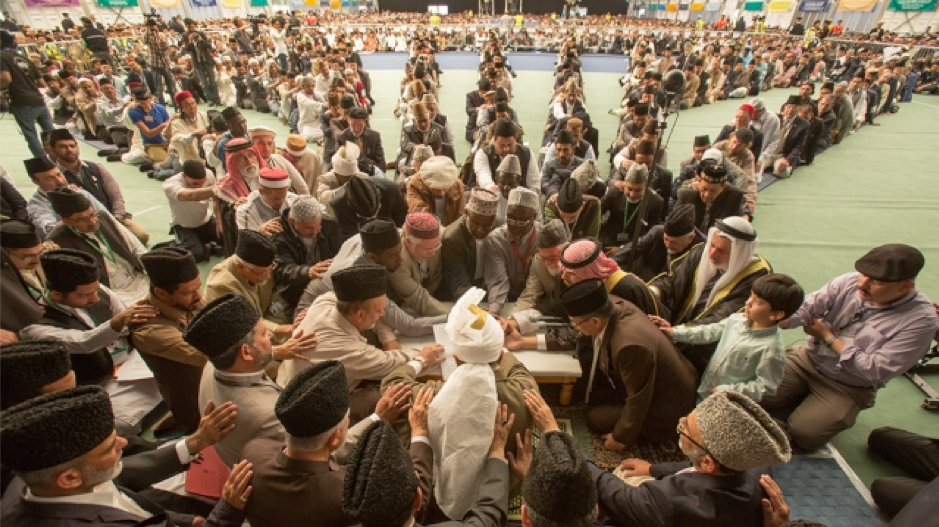
Despite the continued sectarian persecution that Ahmadi Muslims are subjected to in various Muslim majority nations, His Holiness expressly forbids any violence. On 28 May 2010, anti-Ahmadiyya terrorists attacked two mosques belonging to the Ahmadiyya Muslim Community in Lahore, Pakistan. 86 Ahmadi Muslims were martyred during their Friday Prayers, whilst scores more were injured. Despite the barbaric nature of this pre-meditated crime against humanity, His Holiness instructed Ahmadi Muslims worldwide to respond only through prayers and entirely peaceful means.
Keep up to date with the Khalifa on www.KhalifaOfIslam.com from where the above information was extracted.
Contact
National Outreach Department:181 London Rd, Morden SM4 5PT, U.K.
Email: [email protected]Phone: 0208 6877804
@ 2025 Ahmadiyya Muslim Community, All Rights Reserved.